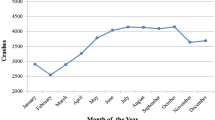Abstract
Herbert Morrison, Minister of Transport in the Labour government of 1929–1931, wrote to the Home Secretary in early 1931, boasting that he had driven about 500,000 miles without an accident.1 Such preening pride would not have been uncommon from some car drivers, but the Minister of Transport was a prominent political figure and his driving record was both exceptional and exemplary in an age of road carnage. Indeed, the confidence he exuded is perhaps a reflection of the faith he, and the second Labour government (1929–1931), held in removing the speed limits for cars under the Road Traffic Act of 1930.2 Indeed, both Morrison and the second Labour government seemed to have acted as conduits for the temporary convergence of opinions of both motoring organisations and chief constables; the former wanting to simply remove speed limits per se, whilst the latter wished to remove some of the contentious speed limits for motorised vehicles, albeit convinced by the evidence, emerging in their annual reports, that it was the pedestrians, not the motorists, who were primarily responsible for road accidents. Yet even if pedestrians contributed significantly to their own deaths and injuries, the decision to remove the speed limit seems remarkably thoughtless, and belied the obvious dangers that the car, and other motorised vehicles, presented on the roads of Britain, regardless of who was at fault.3
Access this chapter
Tax calculation will be finalised at checkout
Purchases are for personal use only
Preview
Unable to display preview. Download preview PDF.
Similar content being viewed by others
Notes
K. Laybourn and D. Taylor (2011), Policing in England and Wales, 1918–1939: The Fed, Flying Squads and Forensics (Basingstoke: Palgrave Macmillan), p. 105. In 1919, there were 331,000 motor vehicles in use in Britain, 110,000 private cars, 115,000 motorcycles, 44,000 buses and coaches and 62,000 goods vehicles. In 1939, the total was 3,085,000, including 1,944,000 cars, 462,000 motorcycles, 53,000 buses and coaches and 495,000 goods vehicles.
Ibid.; The Royal Commission on Transport sat between 1929 and December 1930 before producing three reports in 1931. They were: The Control of Traffic on the Road, The Licensing and Regulation of Public Service Vehicles and The Co-ordination and Development of Transport.
Luckin, ‘Out and About’, pp. 147, 150. Also H. Hendricks (1997), Children, Childhood, and English Society (Cambridge: Cambridge University Press), pp. 83–4, 94. It is essentially the first attempt to provide a historiography of a topic which really had no historiography at the time. He argues that inter-war and post-1945 Britain has been neglected in the study of child histories, even with regard to studies of childhood and the family, class, health and other areas. Also Harry Hendricks (1997), ‘Construction and Reconstruction of Childhood’ in Allison Jones and Alan Proust (eds), Constructing and Reconstructing Childhood: Contemporary Issues in the Sociological Study of Childhood (London: Falmer Press), pp. 83–4, 94; H. Cunningham (1995), Children and Childhood in Western Society since 1500 (London: Longman).
The Original Highway Code: Reproductions of Highway Code booklets from the Thirties, Forties and Fifties (2008) (London: Michael O’Mara Books).
S. O’Connell (1998), The Car in British Society: Class, Gender and Motoring 1896–1939 (Manchester: Manchester University Press), pp. 113–14.
W. Plowden (1971), The Motor Car and Politics 1896–1970 (London: Bodley), p. 258.
C. V. Godfrey (1937), Road Sense for Children (Oxford: Oxford University Press), p. 37; also Laybourn and Taylor, Policing in England and Wales, 1918–1920, p. 146.
City of Liverpool Road Safety Brochure (1953) (Liverpool: Liverpool City Council), p. 47.
The Original Highway Code: Reproductions of Highway Code Booklets from the Thirties, Forties and Fifties (2008) (London: Michael O’Mara Books), p. 6.
Author information
Authors and Affiliations
Copyright information
© 2015 Keith Laybourn and David Taylor
About this chapter
Cite this chapter
Laybourn, K., Taylor, D. (2015). Traffic Accidents and Road Safety: The Education of the Pedestrian and the Child, 1900–1970. In: The Battle for the Roads of Britain. Palgrave Macmillan, London. https://doi.org/10.1057/9781137317858_6
Download citation
DOI: https://doi.org/10.1057/9781137317858_6
Publisher Name: Palgrave Macmillan, London
Print ISBN: 978-1-349-57413-1
Online ISBN: 978-1-137-31785-8
eBook Packages: Palgrave History CollectionHistory (R0)



